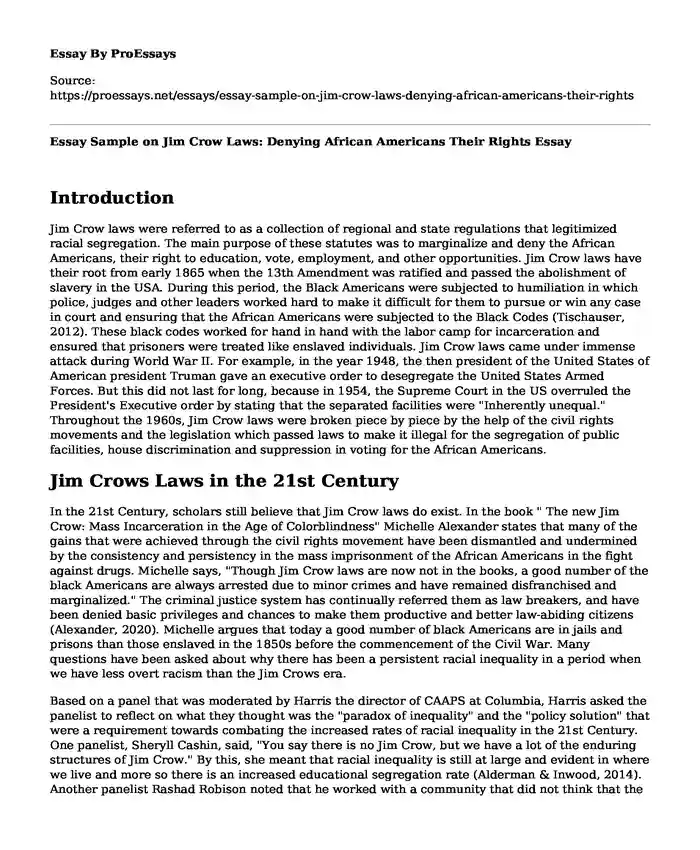Introduction
Jim Crow laws were referred to as a collection of regional and state regulations that legitimized racial segregation. The main purpose of these statutes was to marginalize and deny the African Americans, their right to education, vote, employment, and other opportunities. Jim Crow laws have their root from early 1865 when the 13th Amendment was ratified and passed the abolishment of slavery in the USA. During this period, the Black Americans were subjected to humiliation in which police, judges and other leaders worked hard to make it difficult for them to pursue or win any case in court and ensuring that the African Americans were subjected to the Black Codes (Tischauser, 2012). These black codes worked for hand in hand with the labor camp for incarceration and ensured that prisoners were treated like enslaved individuals. Jim Crow laws came under immense attack during World War II. For example, in the year 1948, the then president of the United States of American president Truman gave an executive order to desegregate the United States Armed Forces. But this did not last for long, because in 1954, the Supreme Court in the US overruled the President's Executive order by stating that the separated facilities were "Inherently unequal." Throughout the 1960s, Jim Crow laws were broken piece by piece by the help of the civil rights movements and the legislation which passed laws to make it illegal for the segregation of public facilities, house discrimination and suppression in voting for the African Americans.
Jim Crows Laws in the 21st Century
In the 21st Century, scholars still believe that Jim Crow laws do exist. In the book " The new Jim Crow: Mass Incarceration in the Age of Colorblindness" Michelle Alexander states that many of the gains that were achieved through the civil rights movement have been dismantled and undermined by the consistency and persistency in the mass imprisonment of the African Americans in the fight against drugs. Michelle says, "Though Jim Crow laws are now not in the books, a good number of the black Americans are always arrested due to minor crimes and have remained disfranchised and marginalized." The criminal justice system has continually referred them as law breakers, and have been denied basic privileges and chances to make them productive and better law-abiding citizens (Alexander, 2020). Michelle argues that today a good number of black Americans are in jails and prisons than those enslaved in the 1850s before the commencement of the Civil War. Many questions have been asked about why there has been a persistent racial inequality in a period when we have less overt racism than the Jim Crows era.
Based on a panel that was moderated by Harris the director of CAAPS at Columbia, Harris asked the panelist to reflect on what they thought was the "paradox of inequality" and the "policy solution" that were a requirement towards combating the increased rates of racial inequality in the 21st Century. One panelist, Sheryll Cashin, said, "You say there is no Jim Crow, but we have a lot of the enduring structures of Jim Crow." By this, she meant that racial inequality is still at large and evident in where we live and more so there is an increased educational segregation rate (Alderman & Inwood, 2014). Another panelist Rashad Robison noted that he worked with a community that did not think that the nation had gotten any better nor changed. He said that racial inequality and segregation were still rooted in many citizens in the United States.
Conclusion
In conclusion, I agree that Jim Crow laws still exist in Black Americans' lives in the United States of America. Based on the discussed as observed by different authors and panelists, it is evident that even though Jim Crow laws may be off the book, Black Americans being the majority-minority groups are faced with residential and educational segregation in the 21st Century. Black Americans are still facing jail sentences due to minor crimes, as opposed to whites.
References
Alderman, D. H., & Inwood, J. O. S. H. U. A. (2014). Toward a pedagogy of Jim Crow: A geographic reading of The Green Book. Teaching ethnic geography in the 21st century, 68-78. https://www.academia.edu/download/36366315/Alderman_Inwood_Teaching_Ethnic_Geography.pdf
Alexander, M. (2020). The new Jim Crow: Mass incarceration in the age of colorblindness. The New Press.
Tischauser, L. V. (2012). Jim crow laws. ABC-CLIO.
Cite this page
Essay Sample on Jim Crow Laws: Denying African Americans Their Rights. (2023, Sep 17). Retrieved from https://proessays.net/essays/essay-sample-on-jim-crow-laws-denying-african-americans-their-rights
If you are the original author of this essay and no longer wish to have it published on the ProEssays website, please click below to request its removal:
- Mary Belle Harris Biography
- American History Questions and Answers Paper Example
- Anzac Day: Remembering NZ's National Identity & Loss of Lives - Essay Sample
- Annotated Bibliography on Child Abuse: Long-Term Health Consequences
- Essay Sample on Mid-19th Century US: Expansion Through Industrialization, Tech, Migration & Agriculture
- Essay Example on Israel-Palestine Conflict: A Century-Old Dispute Over Land
- Essay Example on The Gift of Happiness and Rights: An Insight into Human Dwelling







